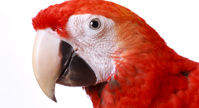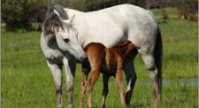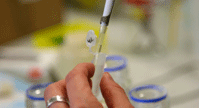Tobiano
Description:
 The tobiano coat pattern is typically characterized with large, rounded white spots on the body and white legs. The spots typically have sharp, clean edges. The head of the horse is usually colored with the base coat color and does not have white caused by the tobiano gene. However, white caused by other genes can appear on the head. The white spots on the body will generally cross the top-line of the horse.
The tobiano coat pattern is typically characterized with large, rounded white spots on the body and white legs. The spots typically have sharp, clean edges. The head of the horse is usually colored with the base coat color and does not have white caused by the tobiano gene. However, white caused by other genes can appear on the head. The white spots on the body will generally cross the top-line of the horse.
Although white is often incorrectly referred to as a color, it is actually the deletion of color. Tobiano is the result of an inversion in the chromosomes, which affects the regulatory regions of the KIT gene. The KIT gene has been found to be involved in numerous horse coat patterns such as the sabino, roan, and dominant white patterns.
The tobiano coat pattern is governed by the dominant KIT gene. This means that only one copy is required for the tobiano coat pattern to be present. If a horse has two copies of the tobiano gene, also known as being homozygous for the tobiano gene (TT), the horse will always pass a copy of the tobiano gene and will always produce tobiano offspring. These horses may display visual clues, such as “ink-spots” or “paw prints.” However, genetic testing is the only way to be sure of the genetic make-up of the horse. If a horse is heterozygous, meaning that it only has one copy (Tt), and is bred to a non-tobiano horse (tt), there is a 50% chance per foal that they will not inherit the tobiano gene.
In 2002, researchers at the University of Kentucky, led by Dr. Samantha Brooks, located a mutation within the KIT gene that is closely linked to the tobiano pattern. Since then, additional markers have been found within the KIT gene by researchers at Animal Genetics. More recently, researchers at the University of Kentucky discovered a chromosomal inversion (a type of genetic mutation) near the KIT gene of tobiano horses. This inversion, which has only been found in tobiano horses, is believed to disrupt the normal functioning of the KIT gene and cause the tobiano pattern.
We use the markers and knowledge of the inversion in order to determine the genetic make-up of the horse. This allows us to tell whether or not the horse will produce the tobiano coat pattern. Furthermore, we are able to determine if the horse is homozygous (TT) or heterozygous (Tt) for the coat pattern. This knowledge becomes especially important when breeding.
References:
Brooks SA, Lear TL, Adelson DL, Bailey E. A chromosome inversion near the KIT gene and the Tobiano spotting pattern in horses. Cytogenet Genome Res. 2007;119(3-4):225-30. Epub 2008 Feb 1.
Brooks, SA, RB Terry, and E. Bailey A PCR-RFLP for KIT associated with Tobiano spotting pattern in horses. Animal Genetics 2002:33(4):301-3.
Test Results:
Animal Genetics offers DNA testing for the Tobiano gene. The genetic test verifies the presence of the chromosomal inversion and presents results as one of the following:
| T/T | Homozygous | Positive for dominant Tobiano gene mutation, carrying two inherited copies of Tobiano. Will always pass Tobiano to foals. For breeding purposes, homozygous Tobiano horses are highly desirable as they are guaranteed to produce Tobiano foals regardless of their mate. |
| n/T | Heterozygous | Positive for the dominant Tobiano gene mutation, carrier of a single inherited copy of Tobiano. Horse's base color may be modified to varying degrees by the Tobiano markings. |
| n/n | Negative | Non-tobiano horse. |
Since Tobiano is only responsible for the white markings of a so called "colored" horse, the test does not determine the horse's base-color. This is determined using the red/black factor test. The two tests in conjunction not only verify the likelihood of Tobiano being passed to foals, but also the likelihood the foals will be piebald or skewbald.
Submit a Sample for Testing:
To submit a sample for testing please click on ORDER and download a sample submission form. Then follow the sample collection and submission instructions.
Cost per sample is $25.00. Please see our Equine Fee Schedule for all equine testing rates.










